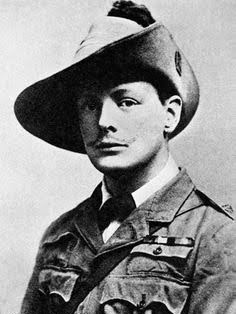SS Induna: Winston Churchill's Connection to New South Wales
by Geoffrey Ball
There is a small memorial plaque and also a small carpark just up the bank. The bow of the SS Induna is mounted in a local park. A South Grafton school is called the Induna School.
Coincidentally the railway bridge over the Clarence is rather unique as it is an opening bridge with the train line below and the road bridge above. If you recall driving over this bridge there is a tight corner at both the north and south ends of the bridge so that the road ends up aligning with the railway line on the south bank – ever wondered why?
A new road bridge has now been built just a little east of the 'old bridge'. The last time I drove to Lismore the bridge was nearing completion but is now open to traffic.
 |
| Winston Churchill during the Boer War |
There
is a historical connection between Sir Winston Churchill and New South Wales.
In October 1899 Winston was sent to Cape Town to cover the Boer War as a war correspondent but was arrested by the Boers and incarcerated as a prisoner of war. He managed a dramatic escape and made his way to Portuguese East Africa – now
called Mozambique – with the help of British sympathizers. He then hitched a
ride back to the United Kingdom, aboard a steamer called the SS Induna.
It was not long after his arrival back in the UK in July 1900 that he commenced his political
life.
 |
| SS Induna in its prime, around 1900 |
So
what happened to the SS Induna? Well she was purchased by Burns Phillip and
from 1904 to 1920 worked the Pacific Islands. She was captured by the Germans
during World War I in the Marshall Islands.
After
the war, she was purchased by New South Wales Railways in 1925 to join the Swallow as a
train ferry across the Clarence River in the north of the state. The north coast line was not complete
and until a railway bridge was built across the Clarence at Grafton these ferries would transfer trains across the river.
After the combined railway and road bridge were built, the SS Induna was moored on the southern bank, about 100 metres west of the bridge and that is where she still lies, but just virtually a part of the bank – see the Google map image below. Many people just would not notice the SS Induna, but its outline can be seen with the help of Google Maps.
 |
| SS Induna broken up in 1932 |
After the combined railway and road bridge were built, the SS Induna was moored on the southern bank, about 100 metres west of the bridge and that is where she still lies, but just virtually a part of the bank – see the Google map image below. Many people just would not notice the SS Induna, but its outline can be seen with the help of Google Maps.
There is a small memorial plaque and also a small carpark just up the bank. The bow of the SS Induna is mounted in a local park. A South Grafton school is called the Induna School.
Coincidentally the railway bridge over the Clarence is rather unique as it is an opening bridge with the train line below and the road bridge above. If you recall driving over this bridge there is a tight corner at both the north and south ends of the bridge so that the road ends up aligning with the railway line on the south bank – ever wondered why?
A new road bridge has now been built just a little east of the 'old bridge'. The last time I drove to Lismore the bridge was nearing completion but is now open to traffic.
Sir
Winston's personality traits came to the fore in the heady days of World War II but they were evident as early as the South African episode. He was a lover of Johnny Walker Red label (amongst other types of alcohol). His arrival in South Africa as a war correspondent was reported as follows: “with his valet and a vast liquor cabinet that included 18 bottles of scotch
whiskey in tow, Churchill arrived in Cape Town in October 1899.”
- Geoffrey Ball is the Secretary of the Shire Military History Club



.png)
.png)

Comments
Post a Comment